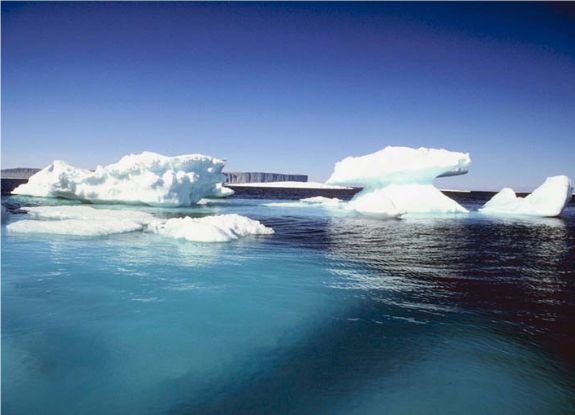|
Picture of the day -
December 19, 2005
Arctic Icebergs Floating Out To Sea

The two coldest regions on
earth are just
about as far away from each other as they can get: the Arctic and Antarctic
circles. The extreme angles at which the
sun's weak rays
strike the polar regions result in the majority of the light being
reflected away, preventing it from being absorbed by the land and seas to build
up heat...therefore these areas stay bitterly cold!
Ice covers the central part of the Arctic and Antarctic circles and much of the surrounding
land masses year-round. Since much of this ice never melts, these layers have
reached amazing depths since the day God created the planet - so we have glaciers.
As the seasons change, the earth goes through regular warming/cooling cycles.
And yes, this includes the polar regions. As the temperatures warm up in the
spring, the ice around the edges of the glaciers begin to melt, causing large
chunks of ice to break off and float away into the sea. These huge chunks of ice
are called icebergs, a term that literally means mountains of ice. And that
name is quite appropriate since the largest ones can be hundreds of feet high
and thousands of feet long!
After an iceberg breaks off from a glacier, it simply floats away into warmer
waters where it eventually melts...a process that actually raises the sea level
by a minute amount. Think of it this way: If you throw an ice cube into a
swimming pool, as it melts the volume of water in the pool increases by the
amount of water originally stored in the ice. It isn't a large change in water
volume - in fact it isn't even measurable. But the water level has increased
none the less.
The creation of icebergs is a natural process that has occurred for eons. The
icecaps melt around the edges and shrink in the spring and summer...only to
refreeze and get larger in the fall and winter.
Some fear that a gradual unnatural warming of the earth due to the
build-up of greenhouse gases and other factors will interrupt this cycle and
result in the melting of glacial ice that will never be replaced. If this
global warming takes place, the earth will change profoundly from the way it is today - and not for
the better. Coastal land around the world will disappear under rising sea
levels and extreme weather will become even more extreme and occur more often
than it does now.
God created an earth in perfect balance, and if it loses that balance all of His
creatures will be affected in a negative way, not just us humans.
Picture Of The Day Homepage |
Submit
a photo
More Interesting Articles
|
|
|